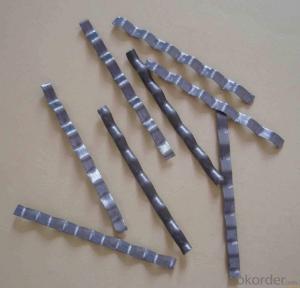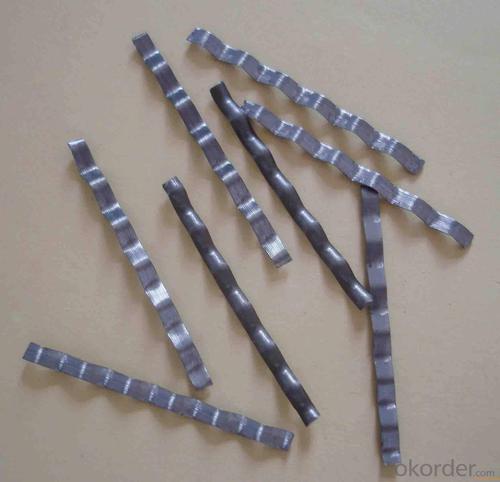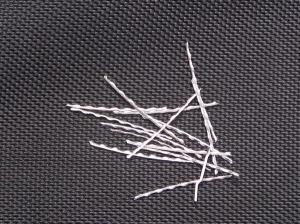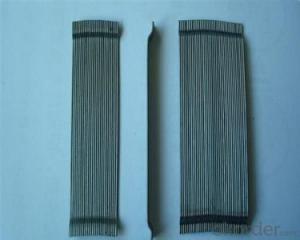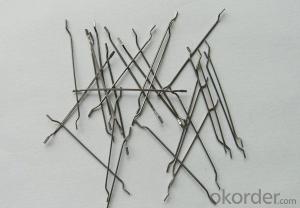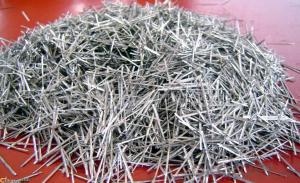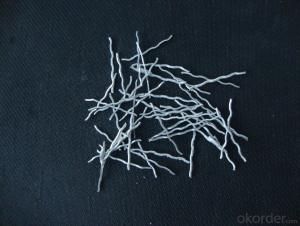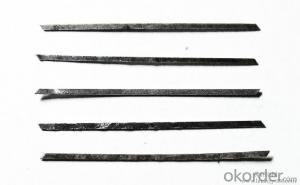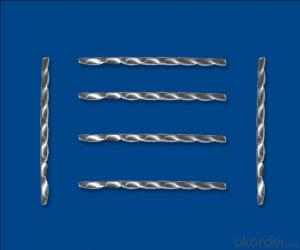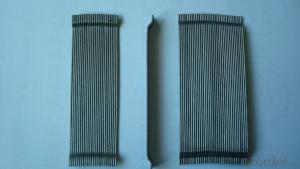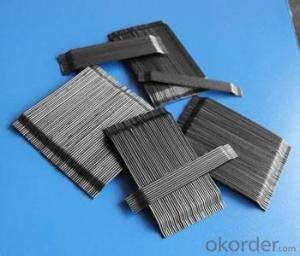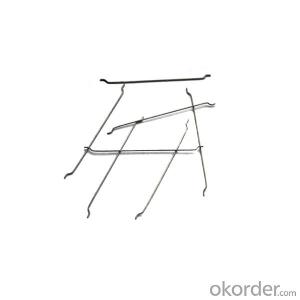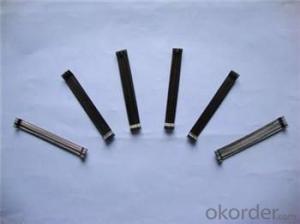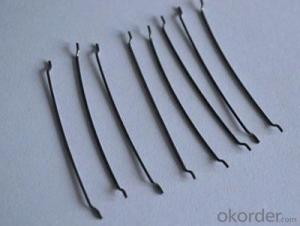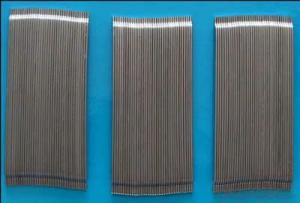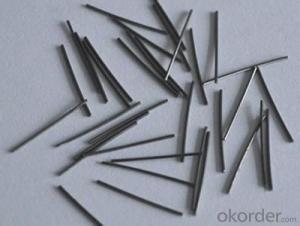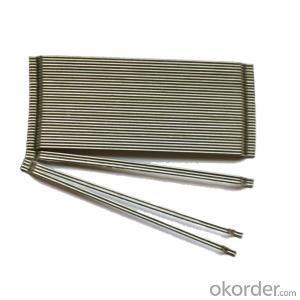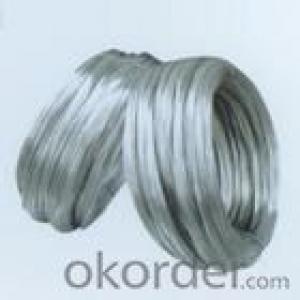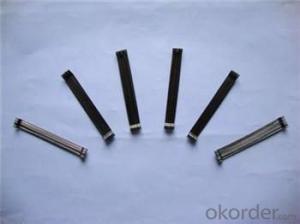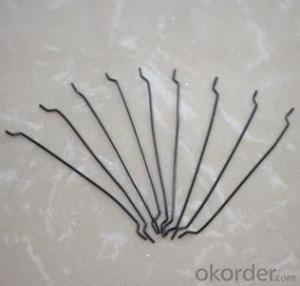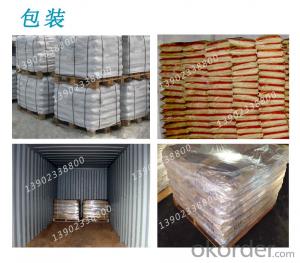Melt Extract Stainless Steel Fiber Reinforced Concrete Construction
- Loading Port:
- Tianjin
- Payment Terms:
- TT OR LC
- Min Order Qty:
- 1000 kg
- Supply Capability:
- 250000 kg/month
OKorder Service Pledge
OKorder Financial Service
You Might Also Like
Quick Details
Place of Origin: Shandong, China (Mainland), Shandong, China (Mainland)
Model Number: GLUED, glued steel fiber
Material: Steel
type: steel fiber for concrete reinforcement
material: steel wire
shape: glued together in a row
appearance: clear and bright
Product features
glued steel fiber together in a row ,is used with cement for construction
Concrete steel fiber is specifically to enhance concrete in its hardened state ,the uniform distribution of steel fiber throughout the concrete greatly improve concrete bonding and tensile strength ,additionally it provides exceptional load stability and durability ,as reliable and efficient concrete reinforcement material
it is widely ued in buildings ,bridges ,thin roo engineering ,highway etc.
Specifications
length :20-60mm
diameter :0.5MM-1.2MM
tensile strengh:>1100Mpa
| diameter | length | tensile strength | |
| 0.5mm | 35mm | 1100Mpa | |
| 0.75 | 60mm | 1100Mpa | |
| 0.9 | 60m | 1100Mpa |
Picture
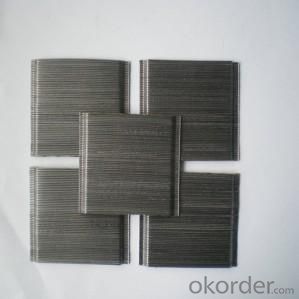
Adhesion into a row
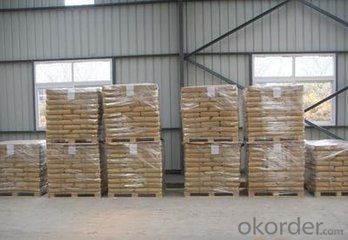
any type
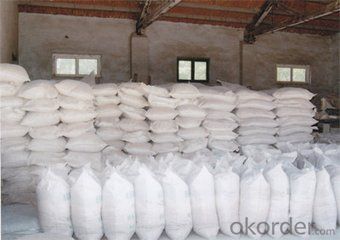
FAQ
we can produce any type steel fiber and of course we can make production according to your requirement
we have specilize in this field for almost 10 years ,with good quality and competitive price
it is widely ued in buildings ,bridges ,thin roo engineering ,highway etc.
length :20-60mm
diameter :0.5MM-1.2MM
tensile strengh:>1100Mpa
- Q: Does melt extract stainless steel fiber improve the resistance to freeze-thaw cycles of concrete?
- Yes, melt extract stainless steel fiber can improve the resistance to freeze-thaw cycles of concrete. These fibers help to enhance the overall durability and performance of concrete by reducing cracking, improving tensile strength, and minimizing the effects of freeze-thaw damage. The stainless steel fibers disperse throughout the concrete matrix, reinforcing it and providing a barrier against water absorption. This ultimately helps to prevent the expansion and contraction of concrete during freeze-thaw cycles, leading to improved resistance and longevity.
- Q: About how much is the steel fiber?
- Different shapes have different production processes, and the prices are different. How much is the measurement unit per ton?. Specific prices, you determine a good model, you can find the company directly consulting online.
- Q: What are the limitations of using melt extract stainless steel fiber in concrete?
- Using melt extract stainless steel fiber in concrete has several limitations. Firstly, the cost of stainless steel fibers is high compared to other types of reinforcing materials. This is because the manufacturing process involves melting and extracting steel, which adds to the overall production cost. Consequently, it may not be cost-effective for projects with tight budgets. Secondly, the addition of stainless steel fibers can make the concrete mix more viscous, making it difficult to handle and place. This can pose challenges during the construction process, particularly when pouring and finishing the concrete. Furthermore, if the stainless steel fibers are not properly coated, there is a risk of corrosion. Although stainless steel is generally resistant to corrosion, it can still be susceptible in environments with high chloride content. This can compromise the durability and longevity of the concrete structure. Moreover, the effectiveness of stainless steel fibers in controlling cracking may vary depending on the concrete mix design and curing conditions. Specific fiber dosages and distribution may be required to achieve the desired crack control properties, adding complexity to the concrete mix design process. Lastly, the addition of stainless steel fibers can impact the aesthetics of the concrete surface. The fibers can be visible on the surface, especially if a smooth finish is desired. This may not be desirable for applications that require a visually appealing finish, such as architectural concrete. In conclusion, while melt extract stainless steel fibers offer benefits in reinforcing concrete, such as increased crack resistance and improved durability, they also have limitations including high cost, increased viscosity of the mix, potential for corrosion, variability in crack control effectiveness, and impact on aesthetics. It is important to carefully consider these limitations when deciding to use stainless steel fibers in concrete applications.
- Q: Is melt extract stainless steel fiber suitable for use in bridge construction?
- Yes, melt extract stainless steel fiber is suitable for use in bridge construction. It offers excellent strength, durability, and corrosion resistance, making it ideal for reinforcing concrete structures in bridges. Additionally, its high tensile strength improves the overall structural integrity and longevity of the bridge.
- Q: Can melt extract stainless steel fiber be used in highway pavements?
- Yes, melt extract stainless steel fiber can be used in highway pavements. It is commonly used as a reinforcement material in concrete to improve its strength and durability, making it suitable for high traffic areas such as highways. Stainless steel fibers offer excellent resistance to corrosion and can enhance the overall performance and lifespan of highway pavements.
- Q: How does melt extract stainless steel fiber affect the carbonation resistance of concrete?
- The addition of melt extract stainless steel fiber can greatly improve the resistance of concrete to carbonation. Carbonation is a chemical process in which carbon dioxide from the atmosphere reacts with the calcium hydroxide in concrete, forming calcium carbonate. This process can decrease the alkalinity of the concrete, leading to corrosion of embedded reinforcement and a decrease in the overall durability of the structure. When melt extract stainless steel fiber is incorporated into concrete, it forms a three-dimensional reinforcement network, which enhances both the mechanical properties and durability of the concrete. These stainless steel fibers act as a physical barrier, reducing the entry of carbon dioxide into the concrete matrix. This barrier effect slows down the carbonation process, effectively increasing the concrete's resistance to carbonation. Moreover, the stainless steel fibers also improve the mechanical properties of the concrete, making it more resistant to cracking and spalling. This increased resistance to cracking further reduces the potential for carbon dioxide to penetrate the concrete, as cracks serve as pathways for gas diffusion. Additionally, the stainless steel fibers provide an extra layer of corrosion protection to the embedded reinforcement, helping to mitigate the effects of carbonation. The fibers function as sacrificial anodes, redirecting any potential corrosion initiation sites away from the reinforcement and onto themselves. This sacrificial anode effect prolongs the service life of the concrete structure by reducing the risk of reinforcement corrosion caused by carbonation. In conclusion, the melt extract stainless steel fiber has a positive impact on the carbonation resistance of concrete by acting as a physical barrier, enhancing mechanical properties, and providing additional corrosion protection to the embedded reinforcement. These advantages contribute to increased durability and extended service life of concrete structures in environments prone to carbonation.
- Q: Can melt extract stainless steel fiber be used in high-rise or tall buildings?
- Yes, melt extract stainless steel fiber can be used in high-rise or tall buildings. This type of fiber is known for its high strength and durability, making it suitable for use in structures that require a high level of structural integrity. Additionally, stainless steel fibers have excellent resistance to corrosion, fire, and extreme temperatures, which are important factors to consider in high-rise buildings. The use of melt extract stainless steel fiber can enhance the overall strength and stability of the building, ensuring its structural integrity and safety.
- Q: Can melt extract stainless steel fiber improve the resistance of concrete to fire?
- Certainly, the incorporation of melt extract stainless steel fiber into concrete has the ability to enhance its fire resistance. Renowned for their elevated melting point, resistance to corrosion, and exceptional heat conductivity, stainless steel fibers are an optimal choice for bolstering the fire resistance of concrete. Upon their addition to concrete, these fibers establish a three-dimensional reinforcement network, effectively preventing the occurrence of cracks and spalling during exposure to fire. Furthermore, the stainless steel fibers serve as a heat sink, proficiently absorbing and dissipating heat, thus significantly impeding the rise in temperature within the concrete and consequently augmenting its fire resistance. Moreover, these fibers fortify the concrete's overall strength and durability, rendering it more resilient to fire and extending its structural integrity even under extreme temperatures. Consequently, the inclusion of melt extract stainless steel fiber in concrete unquestionably improves its resistance to fire.
- Q: How does melt extract stainless steel fiber prevent plastic shrinkage cracking in concrete?
- Melt extract stainless steel fiber is a type of reinforcement material that is commonly used in concrete to prevent plastic shrinkage cracking. Plastic shrinkage cracking occurs when the concrete surface dries out too quickly, causing it to shrink and crack before it has fully hardened. The stainless steel fibers are added to the concrete mix during the mixing process. These fibers are extremely thin and have a high tensile strength, which means they can withstand high stress without breaking. When the concrete starts to dry and shrink, the stainless steel fibers distribute the stress evenly throughout the concrete matrix, preventing the formation of large cracks. The presence of these fibers also helps to reduce the overall drying shrinkage of the concrete. This is because the fibers create a network within the concrete that holds it together and limits the movement of the individual particles. As a result, the concrete experiences less shrinkage as it dries, reducing the likelihood of cracking. Additionally, the stainless steel fibers also improve the overall durability and toughness of the concrete. They enhance the resistance to impact, abrasion, and cracking, making the concrete more resilient and long-lasting. Overall, melt extract stainless steel fiber plays a crucial role in preventing plastic shrinkage cracking in concrete by providing reinforcement and reducing the overall shrinkage of the material. Its addition to concrete mixes helps to ensure that the concrete surface remains intact and structurally sound, even during the early stages of drying and hardening.
- Q: What is the typical fiber length and diameter of melt extract stainless steel fiber?
- The typical fiber length and diameter of melt extract stainless steel fiber can vary depending on the specific manufacturer and product, but generally, the fiber length ranges from 10 to 25 millimeters, while the diameter ranges from 20 to 50 micrometers.
Send your message to us
Melt Extract Stainless Steel Fiber Reinforced Concrete Construction
- Loading Port:
- Tianjin
- Payment Terms:
- TT OR LC
- Min Order Qty:
- 1000 kg
- Supply Capability:
- 250000 kg/month
OKorder Service Pledge
OKorder Financial Service
Similar products
Hot products
Hot Searches
Related keywords
